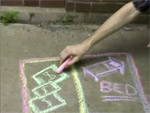 Course: Writing 3
Course: Writing 3
Instructor: Prof. Karen Gocsik
Assignment: The Dartmouth Research/Documentary Project
Introduction
I make this assignment – a short documentary film about some aspect of Dartmouth life and history – in the middle of Writing 2. Using general resources, special collections, interviews, and perhaps the archives of the Daily Dartmouth, students (in groups of three) research a topic of their choice, looking not only for textual information but also for visual and audio resources. They then produce a 5 – 7 minute multi-media composition/documentary film. They also compose, collaboratively, a paper on the same subject as the film. I subsequently engage them in conversation regarding the similarities and differences of composing with different media. What skills are universal? Portable? Genre-specific?
My aim is to introduce students to finding and using primary and secondary sources, and to familiarize them with the challenges of composing an argument with multiple media. The project itself requires considerable writing and rewriting, including the proposal, the interview questions, the narrative voice-over, and the final paper. The project also requires that students research well, present their research ethically, and cite their sources when credits roll at the film’s end.
Ongoing Work
I begin by introducing my students to examples of multi-media compositions, both professional documentaries and student films. We talk about how these films are constructed, considering the soundness and the ethics of their arguments.
We follow this with two sessions with a reference librarian in Rauner. For the first session, the Rauner librarian pulls documents, images, and artifacts from Dartmouth’s history – for instance, materials on student activism through the ages. Students are encouraged to play with the resources, to comment on what they’ve learned, and to form questions for further research. In the second session the librarian discusses the Rauner resources more thoroughly and offers instruction in doing research with primary sources.
The students then meet with their groups to determine a topic and a plan. They take this plan to the RWIT Center, where a tutor reviews the plan and makes suggestions about its focus and feasibility. Students then go to Jones Media Center to discuss technology options/needs. Finally, they create a proposal in which they are instructed to:
- State your topic and the questions you intend to pursue
- Offer a detailed plan regarding how, precisely, your group intends to explore these questions (For instance, do you intend to conduct interviews? With whom? Will you need to film something on campus? What? Do you intend to make use of special collections? Which ones?)
- Provide a timeline for your project
- List your technology needs
- Raise any questions that you have regarding the process
Students write their proposals, then meet with me in office hours, to “pitch” their ideas and discuss their strategies.
Students meet several times amongst themselves to do research, to refine their plan, and to write their scripts. They must submit scripts and reports to me according to deadlines that I’ve outlined in the syllabus.
Finally, they begin shooting. They bring clips to an i-movie workshop, run by Susan Simon, who offers instruction in how to use this software. Students edit their films in Jones Media Center, with the support of the Jones Staff and, ideally, an RWIT tutor. They also invite me to Jones to take a look at their rough cuts. I offer my critique, and they continue editing.
We screen the films on a movie night in the last week of class. Students assess their peers’ work and defend their own in a Q&A following each film. I provide popcorn.
Assessment
I assess both the product and the process of this project.
Product
Because film is a public medium, I invite the entire class to screening nights. At the screenings the filmmakers are asked not only to present their own films but also to assess their peers’ work. Before the final screening – before students cut their films – I invite them to join me in constructing criteria for assessment. I ask them to consider global and technical issues, and to determine whether or not the argument was ethically made. I average the group assessment numbers to determine a grade for the film. Student filmmakers share this grade, regardless of their involvement in the film.
Process
Whenever you have students work in groups, it’s a good idea to give them an opportunity to assess their classmates, and to assess themselves. I’ve therefore developed a series of questions that I ask students to complete as part of their group assessment. I use this assessment to determine a process grade, which I sometimes express as a letter grade and sometimes as a plus or minus. Students are awarded these grades as individuals, depending on their individual performances.
What I Hope to Achieve
This assignment accomplishes many things, in terms of research, critical thinking, composing, and so on.
Research
- Introduce students to the research process (in a way that is new to them and fully engaging)
- Give students the opportunity to work with primary sources
- Familiarize the students with Rauner resources
- Expand students’ sense of viable source materials, to include audio and visual
- Teach students how to evaluate, use, and cite these kinds of sources
Critical Thinking
- Teach students how to read and to interrogate visual texts
- Enable students to better analyze whether or not a visual text is “ethical”
Composing/Editing
- Teach students how to structure arguments in new ways (documentary films do not typically have explicit thesis sentences; they are sometimes not structured linearly; they are often polyglossic; etc.).
- Teach students to edit carefully, especially by heightening their awareness of transitions and connections between ideas within the piece.
- Require students to write a group paper on the same topic, so that they can discover the similarities and differences in composing with different media
Additional Benefits
- Build the class community (students work closely in small groups)
- Familiarize students with Dartmouth culture and history
- Expose students to Rauner Library, the RWIT Center, and Jones Media Center
Frequently Asked Questions
Why small groups?
I think students learn more from multimedia projects when they work collaboratively. First, film is a collaborative medium. But even more important, groups allow students to discuss each step of the composing process. Students have reported that they’ve argued for an hour over a single transition! This level of discussion doesn’t happen when students write papers. And it cannot happen if they work alone.
How much class time do I devote to this?
I devote four to six classes to this project: one or two to a discussion of visual arguments, two to Rauner, one or two to the i-movie workshop. Several of these classes are x-hours; four are run by colleagues. I spend out-of-class time with each group, especially when they pitch their ideas to me and when I view their rough cuts.
How much time do the students devote to this?
It depends. Students will spend several hours researching, shooting, and editing. Editing is, by far, the most time-consuming of all the processes. Students are often surprised by this; instructors need to remind students again and again that it takes a long time to “shape” their films. If you’re concerned about the amount of time this project requires, ask students to create their arguments from existing photos or video footage. This will keep them from spending considerable time on shooting.
What do I give up to accomplish this project?
Not much. This project proceeds not in place of, but alongside the other course assignments. We continue to read and discuss course materials as students work on their films. Instead of four books, I teach three; the film and group paper replace one paper – but this project, as designed, is far more demanding than a single paper.
What do students gain?
Students gain several things from this project:
- Students’ visual literacy improves, as they sharpen their understanding of how visual texts are constructed.
- Students learn to do research with primary sources, including archival sources and interviews.
- Students practice collaborative composing as they conceptualize, research, shoot, and edit together.
- Students develop a keener understanding of composition, learning how to create an argument without offering an explicit thesis; how to use multimedia resources to support an argument; how to create effective transitions between their ideas; and how to develop a visual “voice.”
- Students consider the ethics of their visual arguments.
- Students have fun collaborating together, a process that improves, incidentally, the community of the class.
Example of Final Project
[youtube JVIpI01A9q4]





 Course: Writing 5
Course: Writing 5  Course: Writing 3
Course: Writing 3
